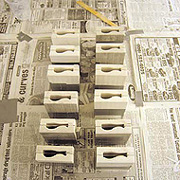|
"Cacht" Project Report  Download PDF version Download PDF version
James Forren Project Team: Elliot Felix, Marie Law, Nic Rader, Mat Laibowitz |
|
"Cacht" Project Report  Download PDF version Download PDF version
James Forren Project Team: Elliot Felix, Marie Law, Nic Rader, Mat Laibowitz |
|
In addition to documenting the work, "Cacht," this report will provide a guide for anyone who wishes to repeat the project. Step 1. Goal Definition. The goal of "Cacht" is to examine the concept of generosity. In order to do this we recommend defining three criteria: 1. the budget, 2. the community and 3. the object. The definition of these criteria is not to be done individually, but in a group of at least 3 people and no more than 6. The aspects of generosity "Cacht" seeks to address are: a. its definition, b. its enactment and c. it beneficiaries. During our group's initial discussions we found that what we assumed was a fairly cut-anddry definition could, in fact, be looked at in a way that lent ambiguity to the concept. Meaning, initially we assumed the act of giving was generous, and the act of keeping was selfish. However, the more variables we introduced into both the initiation and consequence of giving and keeping, the more we were able to define actions that were simultaneously selfish and generous. This is the first criteria of "Cacht": to define an act of apparent generosity which has, instead, either contradictory or competing implications. The budget is a key component in "Cacht." It will determine the size of a community your group can address, as well as the nature and quality of the objects you produce. We recommend that the smaller the budget, the more finite a community you choose to engage. With a budget of $150, some communities we considered addressing were a local business, a local shelter and a local gallery. Likewise, because "Cacht" can frequently employ the direct distribution of money, we recommend that whatever object is made be significantly inexpensive; relying especially on free resources available to your group. As students in a major university we were fortunate enough to have a wide and sophisticated array of technical resources at our disposal. The community to be addressed should, in some way, be able to benefit from your group's involvement in their daily operation. That is to say, whatever you propose should not inhibit or impinge in any way on the day-to-day activities they depend on to survive. Whether it is money they receive, added interest in their operations, publicity or some other benefit, the benefit of your project to their operations should be clearly identified. This is crucial in your group's next step: contacting the community. We recommend contacting the person in charge. It is helpful if some member of your group has a personal or institutional contact with the community. Our group was, again, fortunate enough to have two major connections to our community, the List Gallery at MIT. Firstly, we were all members of the MIT community. Secondly, our work was affiliated with a course taught by an artist wellknown to the gallery's staff. In return, we were extraordinarily fortunate to not only have the gallery welcome the opportunity to work with us, but to take an active role in helping us realize the project. This kind of cooperation is ideal, for it draws on a wider pool of resources, as well as resources inherent or indicative to the community the project seeks to address. |
    |
|
next >> |